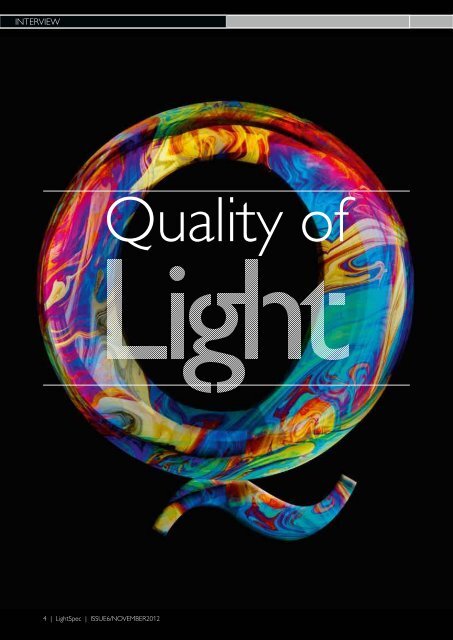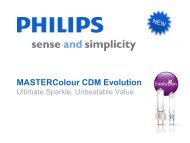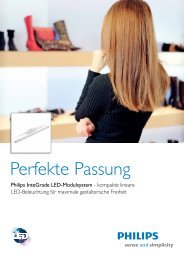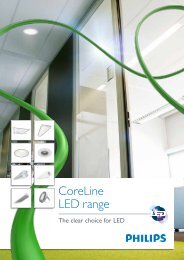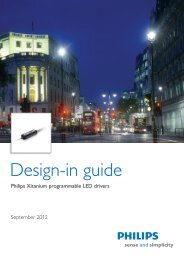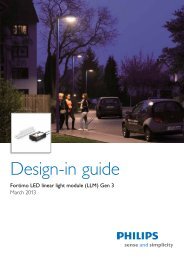Quality of light and the - Philips Lighting
Quality of light and the - Philips Lighting
Quality of light and the - Philips Lighting
Create successful ePaper yourself
Turn your PDF publications into a flip-book with our unique Google optimized e-Paper software.
iNtERViEW<br />
4 | Lightspec | issuE6/NoVEMBER2012<br />
<strong>Quality</strong> <strong>of</strong><br />
taking <strong>the</strong><br />
measure <strong>of</strong><br />
LED <strong>light</strong><br />
quality.<br />
<strong>the</strong> consumer buying <strong>light</strong> for <strong>the</strong> home expects<br />
all <strong>of</strong> <strong>the</strong> above, but also a <strong>light</strong> source which<br />
works well <strong>and</strong> gives a pleasant <strong>light</strong> when used<br />
with transformers <strong>and</strong> dimmer switches.<br />
For <strong>the</strong> <strong>of</strong>fice user quality <strong>of</strong> <strong>light</strong> might be<br />
characterized by <strong>the</strong> uniformity <strong>of</strong> <strong>light</strong> coming<br />
from <strong>the</strong> luminaire, illuminating <strong>the</strong> work space<br />
with a homogenous <strong>light</strong><br />
pattern. Everyone has <strong>the</strong>ir<br />
own expectations <strong>and</strong> ideas<br />
concerning quality <strong>of</strong> <strong>light</strong>.<br />
<strong>Quality</strong> <strong>of</strong> <strong>light</strong> has played an<br />
important role throughout<br />
<strong>the</strong> ages <strong>of</strong> conventional<br />
<strong>light</strong> sources <strong>and</strong> luminaires<br />
<strong>and</strong> has generally improved over time. Most<br />
<strong>light</strong>ing pr<strong>of</strong>essionals will recognize <strong>the</strong> difference<br />
in quality between <strong>the</strong> halophosphate <strong>and</strong><br />
triphosphor fluorescent tubes, or <strong>the</strong> difference<br />
between <strong>the</strong> flickering <strong>of</strong> electromagnetically<br />
driven fluorescent luminaires versus <strong>the</strong> smooth<br />
high frequency electronic fluorescent luminaires.<br />
Consumers have always been able to recognize<br />
<strong>the</strong> difference in quality <strong>of</strong> <strong>light</strong> between<br />
compact fluorescent lamps <strong>and</strong> inc<strong>and</strong>escent<br />
<strong>light</strong> bulbs in <strong>the</strong> home, even if <strong>the</strong>y could not<br />
voice <strong>the</strong> technical parameters why. a colour<br />
rendition <strong>of</strong> CRi 80 is not <strong>the</strong> same as CRi 100.<br />
Nor is a lamp lumen run up time <strong>of</strong> 5 minutes<br />
<strong>the</strong> same as instant maximum <strong>light</strong> output. <strong>the</strong>y<br />
experience it, feel it <strong>and</strong> know it is different.<br />
<strong>the</strong> main example <strong>of</strong> improvement in quality<br />
<strong>of</strong> <strong>light</strong> that many <strong>light</strong>ing pr<strong>of</strong>essionals will<br />
“Consumers have<br />
always been<br />
able to recognise<br />
quality <strong>of</strong> <strong>light</strong>.”<br />
annetta Kelso,<br />
senior Marketing Manager LED systems,<br />
<strong>Philips</strong> <strong>Lighting</strong><br />
www.philips.com/<strong>light</strong>spec<br />
<strong>Quality</strong> <strong>of</strong> <strong>light</strong> encompasses many things <strong>and</strong> <strong>the</strong>se can be very different<br />
depending on <strong>the</strong> application or <strong>the</strong> person you ask. For <strong>the</strong> clo<strong>the</strong>s retailer quality<br />
<strong>of</strong> <strong>light</strong> might mean colour rendition <strong>and</strong> <strong>the</strong> depth <strong>of</strong> saturation <strong>of</strong> colours in<br />
material, whereas <strong>the</strong> food retailer might see quality <strong>of</strong> <strong>light</strong> as <strong>the</strong> consistency <strong>of</strong><br />
<strong>the</strong> colour temperature <strong>of</strong> white lamps in <strong>the</strong> ceiling, or <strong>the</strong> psychology behind <strong>the</strong><br />
choice <strong>of</strong> a particular colour temperature.<br />
remember is <strong>the</strong> switchover from quartz metal<br />
halide lamps to ceramic metal halide lamps in<br />
1994. it was a great relief for retailers to be able<br />
to get rid <strong>of</strong> <strong>the</strong> dreadful pink, green, blueish<br />
white colour shift visible from lamps right next to<br />
each o<strong>the</strong>r. sales <strong>of</strong> lamps with ceramic discharge<br />
technology, such as <strong>the</strong> <strong>Philips</strong> MastERColour,<br />
rose dramatically year<br />
upon year <strong>and</strong> became<br />
firmly established in <strong>light</strong>ing<br />
specifications. Ceramic<br />
discharge lamps are<br />
now one <strong>of</strong> <strong>the</strong> ultimate<br />
examples <strong>of</strong> high quality <strong>of</strong><br />
<strong>light</strong>, having made continuous<br />
leaps forward in spectral<br />
composition <strong>and</strong> control <strong>of</strong> <strong>the</strong> <strong>light</strong>.<br />
<strong>Quality</strong> <strong>of</strong> <strong>light</strong> in general has always been<br />
an issue that has surfaced, been solved <strong>and</strong><br />
resurfaced again.<br />
// Colour consistency<br />
When a new technology comes in to an existing<br />
market <strong>the</strong>re is usually a period in which<br />
<strong>the</strong> new technology does not yet outperform<br />
<strong>the</strong> incumbent technology, but <strong>of</strong>fers additional<br />
features that are so attractive that people start<br />
overlooking <strong>the</strong> (temporary) lower performance.<br />
think <strong>of</strong> flat screen televisions, or laptops over<br />
desk top computers. With <strong>the</strong> advent <strong>of</strong> LEDs<br />
as a credible <strong>light</strong> source for general <strong>light</strong>ing, <strong>the</strong><br />
same pattern could be seen. Lumen packages<br />
<strong>and</strong> efficiency were not better than certain<br />
conventional <strong>light</strong> sources, but general expectation<br />
was that this was just a matter <strong>of</strong> time.<br />
issuE6/NoVEMBER2012 | Lightspec | 5


